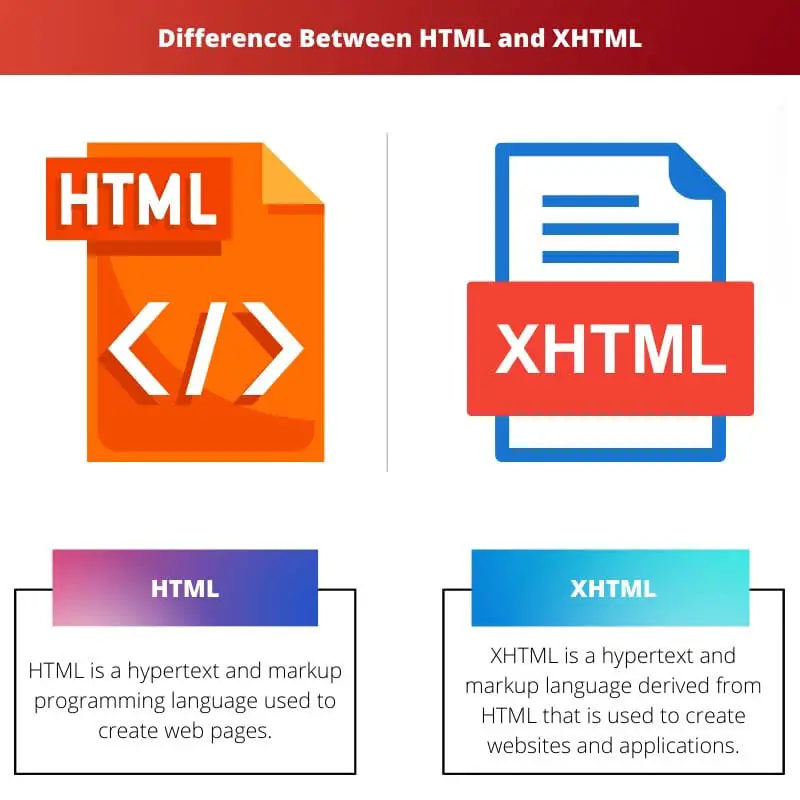Programming languages are used to develop, communicate or process certain programs on a computer. Moreover, a set of instructions are written by a programmer to perform certain tasks on the computer.
HTML and XHTML are two types of web development programming languages used to create web pages. HTML and XHTML may seem similar to each other, yet they are extremely different.
Key Takeaways
- HTML is a markup language used for creating web pages, while XHTML is a stricter version of HTML that adheres to XML syntax.
- XHTML requires well-formed code with properly nested tags and attributes, while HTML is more forgiving of syntax errors.
- XHTML is more modular and extensible than HTML, allowing easier integration with other XML-based technologies.
HTML vs XHTML
The difference between HTML and XHTML is that Hypertext Markup Language (HTML) is a hypertext and markup programming language used to create web pages, while Extensible Hypertext Markup Language (XHTML) is a hypertext and markup programming language derived from HTML. HTML doesn’t have a case-sensitivity nature; hence the lists, tags, and attributes can either be written in uppercase or lowercase, while XHTML can be case-sensitive.

HTML is known as Hypertext Markup Language. HTML is a programming language that is widely used by programmers to create web pages. It is hypertext and markup language that enables the programmer to link one text to another.
Therefore, it is a simple programming language that allows a human being to read and understands effortlessly.
XHTML is known as Extensible Hypertext Markup Language. It is a programming language created from HTML that is used to develop web pages. XHTML is similar to HTML, but the codes are a lot more accurate and perfect than HTML.
XHTML is a hypertext and markup language that allows the programmer to link one text to another, and humans can comprehend it easily.
Comparison Table
| Parameter of Comparison | HTML | XHTML |
|---|---|---|
| Initialism | Hypertext Markup Language | Extensible Hypertext Markup Language |
| Meaning | HTML is a hypertext and markup programming language used to create web pages. | XHTML is a hypertext and markup language derived from HTML that is used to create websites and applications. |
| Tags | Nest Tags are not used in HTML. | Nest Tags are used in XHTML. |
| Case Sensitive | HTML doesn’t have a case sensitivity nature hence the codes can either be written in uppercase or lowercase. | XHTML can be case-sensitive; hence, only lower case is used. |
| Error Management | Error in HTML can be easily rectified | Error in XHTML is not easily rectifiable. |
| Applications | HTML is used to create web pages, game development, and internet navigations. | XHTML is used to create excellent and well-structured web pages. |
What is HTML?
Hypertext Markup Language (HTML) describes the structural details of web pages. HTML was founded by Tim Berners Lee in 1991. It is a simple and well-defined programming language that can be easily grasped by a non-programmer.
HTML comprises a three-way listing. They are ordered lists, unordered lists, and defined lists. In ordered lists, <ol> tag is used to create, and ordered lists are created by just adding the items of your choice without being bulleted.
The numbering of ordered lists can be created using type attributes. For instance, number 1 can be created by <ol type=” 1 “>. Start attributes are also used to specify the starting points of ordered lists.
An unordered list <ul> tag is used created, and every item is marked bulleted. Type attributes are used to define the type. For instance, <ul type=”square” is used to create the desired square bullet type.
Defined lists in HTML are a type of list where the items are described as an encyclopedia. In the defined list, three tags are used <dl> tag, <dt> tag, and <dd> tag.
They are used to define the start and end of the list. The applications of HTML include web development, internet navigation, and game and application development.

What is XHTML?
Extensible Hypertext Markup Language (XHTML) is used to create excellent web pages. Therefore strict measures are to be followed during the development process.
XHTML was founded by World Wide Web Consortium in 2000. XHTML is a hypertext and markup language formulated from HTML.
XHTML is extremely case-sensitive. Hence strict measures are followed while writing the codes. XHTML is written using tags in standard English. Paragraph and break tags such as <p>, </p> and <br> are used to write paragraphs and to add a line break to the paragraphs.
In XHTML, there are three ways to align the text, and they are right, left, and centre. For instance, <p style=”text-align: right;”> text </p> tag is used to align text on the right, <p style=”text-align: left;”> text </p> is used to align text in the left and <p style=”text-align: centre;”> text </p> is used to align text in the centre.
XHTML consists of two types of listing. They are an ordered list or numeral list, an unordered list, or a bullet points list. Cascading Style Sheets (CSS) are added with XHTML to create well-formatted codes.
CSS allows engaging with numerous properties, such as creating a section break in the centre and adding multiple styles within the <head>. The application of XHTML includes web page development.

Main Differences Between HTML and XHTML
- HTML is known as Hypertext Markup Language. On the other hand, XHTML is known as Extensible Hypertext Markup Language.
- HTML is a hypertext and markup language used to create web pages. On the other hand, XHTML is a hypertext and markup language formulated from HTML.
- HTML is generated from Standard Generalized Language (SGL). On the other hand, XHTML is generated from HTML.
- Nest Tags are not used in HTML. On the other hand, Nest tags are used in XHTML.
- HTML doesn’t have a case sensitivity nature. On the other hand, XHTML is extremely case-sensitive.
- HTML codes can either be written in uppercase or lowercase. On the other hand, XHTML codes can only use lowercase.
- HTML doesn’t have strict measures to follow. On the other hand, XHTML has strict measures to follow.

- https://books.google.com/books?hl=en&lr=&id=O5Vpwv0wTYUC&oi=fnd&pg=PT9&dq=HTML+and+XHTML&ots=YNuYusAO2M&sig=b8h6QXGkEPlybfhPsPCn5w-LPoI
- https://books.google.com/books?hl=en&lr=&id=kLfQQShrTXoC&oi=fnd&pg=PT20&dq=HTML+and+XHTML&ots=vIo64Kf_SN&sig=-Q0DakKqDuiExlG2sCjUR648qcY
- https://books.google.com/books?hl=en&lr=&id=LYSUt2saFVIC&oi=fnd&pg=PR29&dq=HTML+and+XHTML&ots=mZBrUQtS1Y&sig=yR6Zc-zaHGRNuS7NA3SVwm7mwtY


